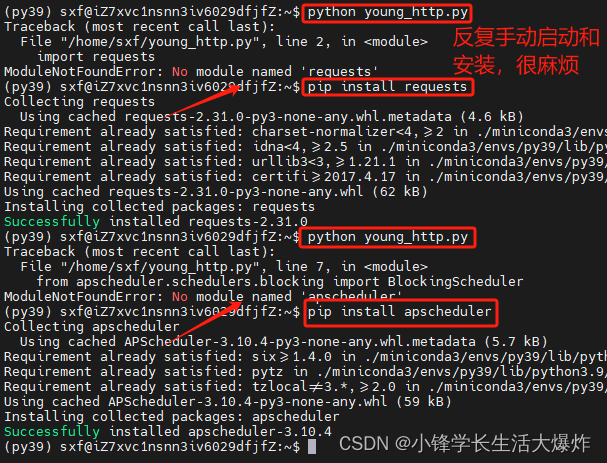【教程】自动检测和安装Python脚本依赖的第三方库
发布时间:2023年12月28日
转载请注明出处:小锋学长生活大爆炸[xfxuezhang.cn]
背景说明
? ? ? ? 对于新python环境,要运行某个脚本,可能需要安装很多库,一般可以通过提供的requirements.txt来自动安装。但如果没有这个txt,那就得手动一个一个安装,非常的麻烦。

? ? ? ? 通过捕捉ImportError错误,实际上可以从错误消息中提取缺失的模块名称,而一旦确定了缺失的模块名称,就可以使用 pip 自动安装它们了。
参考脚本
autoDependencyInstaller.py
import argparse
import subprocess
import sys
import re
def install_module(module_name, python_executable):
try:
subprocess.check_call([python_executable, "-m", "pip", "install", module_name])
return True
except subprocess.CalledProcessError:
return False
def extract_imports(file_name):
with open(file_name, 'r') as file:
file_content = file.read()
imports = re.findall(r'^(?:from\s+(\S+)|import\s+(\S+))(?:\s+|$)', file_content, re.MULTILINE)
top_level_modules = {imp[0].split('.')[0] if imp[0] else imp[1].split('.')[0] for imp in imports}
return list(top_level_modules)
def check_module(module, python_executable):
try:
subprocess.check_call([python_executable, "-c", f"import {module}"])
return True
except subprocess.CalledProcessError:
return False
def check_and_install_modules(modules, python_executable):
for module in modules:
if check_module(module, python_executable):
print(f"模块 '{module}' 已存在.")
else:
print(f"尝试安装模块: {module}")
if not install_module(module, python_executable):
correct_name = input(f"安装 '{module}' 失败。请输入正确的包名,或按 Enter 跳过: ").strip()
if correct_name:
install_module(correct_name, python_executable)
def main():
parser = argparse.ArgumentParser(description="自动检测和安装 Python 脚本依赖.")
parser.add_argument("script", help="要检查依赖的 Python 脚本文件名")
parser.add_argument("-p", "--python-path", help="Python 解释器的路径(可选)", default=sys.executable)
args = parser.parse_args()
modules_to_check = extract_imports(args.script)
check_and_install_modules(modules_to_check, args.python_path)
if __name__ == "__main__":
main()
????????参数第一项表示目标py文件。第二项表示要用道德python路径,如果没有给,则默认使用当前环境下的python
? ? ? ? 这个脚本只提取 Python 脚本中的 import 和 from ... import 语句,然后在当前脚本中尝试导入它们。这样做的好处是,不会执行原始脚本的其他部分,只会检查依赖项是否存在。如果遇到任何 ImportError,则可以安装相应的缺失模块。这种方法更加安全和高效,因为它避免了不必要的脚本执行。
使用示例
python autoDependencyInstaller.py <目标py文件> <目标python路径>比如:
python autoDependencyInstaller.py young_http.pypython autoDependencyInstaller.py young_http.py -p /home/sxf/miniconda3/envs/py39/bin/python
进阶使用
????????把这个脚本打包:
pip install pyinstaller
pyinstaller -F -w autoDependencyInstaller.py????????生成的二进制文件在dist目录下,所以就可以非常方便的使用了:
./dist/autoDependencyInstaller young_http.py -p /home/sxf/miniconda3/envs/py39/bin/python
注意:对于打包的文件,必须提供-p,不然用的是二进制文件自己的环境,会出问题。
? ? ? ? 或者可以直接这样,用$(which python):
./dist/autoDependencyInstaller young_http.py -p $(which python)更进阶使用
? ? ? ? 把这个文件放到系统目录下,就不用每次都找了:
sudo mv dist/autoDependencyInstaller /usr/sbin/? ? ? ? 以后就可以直接用了:
autoDependencyInstaller young_http.py -p /home/sxf/miniconda3/envs/py39/bin/python
文章来源:https://blog.csdn.net/sxf1061700625/article/details/135263741
本文来自互联网用户投稿,该文观点仅代表作者本人,不代表本站立场。本站仅提供信息存储空间服务,不拥有所有权,不承担相关法律责任。 如若内容造成侵权/违法违规/事实不符,请联系我的编程经验分享网邮箱:chenni525@qq.com进行投诉反馈,一经查实,立即删除!
本文来自互联网用户投稿,该文观点仅代表作者本人,不代表本站立场。本站仅提供信息存储空间服务,不拥有所有权,不承担相关法律责任。 如若内容造成侵权/违法违规/事实不符,请联系我的编程经验分享网邮箱:chenni525@qq.com进行投诉反馈,一经查实,立即删除!
最新文章
- Python教程
- 深入理解 MySQL 中的 HAVING 关键字和聚合函数
- Qt之QChar编码(1)
- MyBatis入门基础篇
- 用Python脚本实现FFmpeg批量转换
- 从零开始实现神经网络(三)_RNN循环神经网络
- 【Python程序开发系列】5000字总结:Git-Fork模式下软件开发的工作流程和常用命令
- VueRouter的路由模式有哪几种
- docker 使用
- 鸿海旗下半导体设备大厂京鼎遭黑客入侵 | 百能云芯
- Docker入门
- SpringBoot系列之基于Jedis实现分布式锁
- flex 属性
- 前端开发之通过vue-office组件实现文件预览
- 五、PCIE开发之XDMA使用